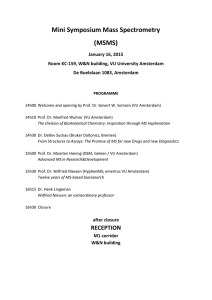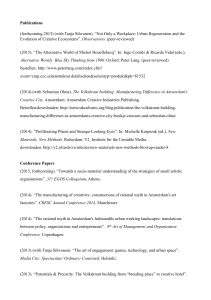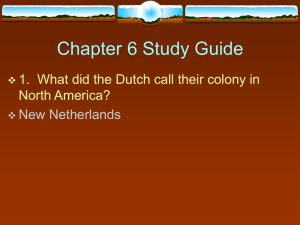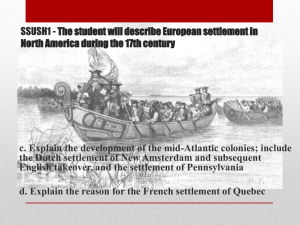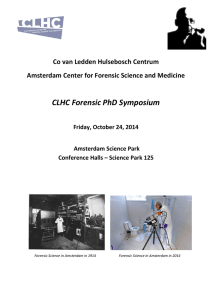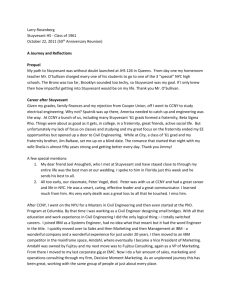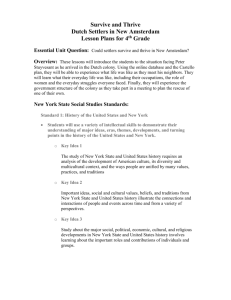New Amsterdam
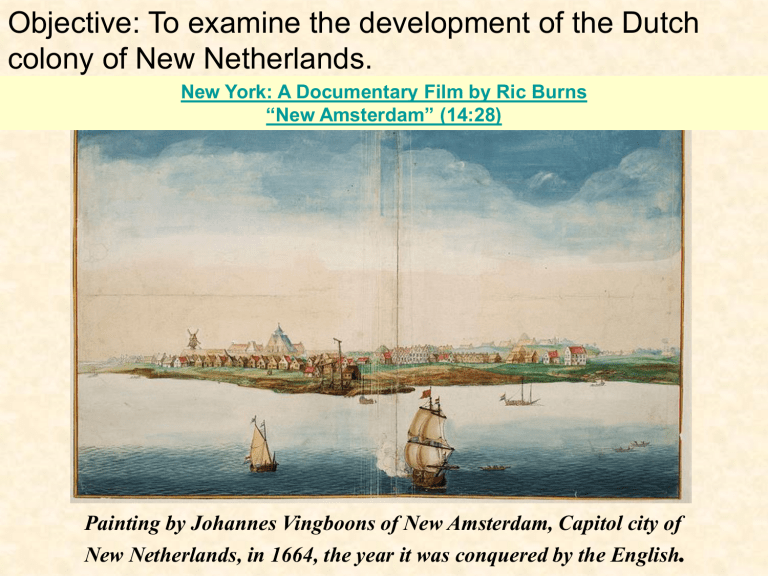
Objective: To examine the development of the Dutch colony of New Netherlands.
New York: A Documentary Film by Ric Burns
“New Amsterdam” (14:28)
Painting by Johannes Vingboons of New Amsterdam, Capitol city of
New Netherlands, in 1664, the year it was conquered by the English
.
• http://www.youtube.com/watch?v=pG17tzt
QYNQ
• Dutch West India Company
–Trading company
• First settlements – fur trading posts
–Owners controlled the settlement
–Welcomed all people
• “Diversity”
• Read the Articles on this company
• The Dutch West India Company set up the colony of
New Amsterdam in what is today New York City in 1624 .
• Originally settled by 110 Dutch laborers in 1624, the first eleven slaves were brought to
New Amsterdam from Angola two years later.
New Amsterdam slave auction, 1655
• In what the Native Americans thought was a temporary arrangement, the Dutch bought the island of Manhattan for
60 gilders, or approximately $600.
A 1909 postcard depicts the acquisition of Manhattan by the
Dutch. The artifact was part of an exhibit at the Museum of the
City of New York commemorating the 400th anniversary of Henry
Hudson’s voyage to modern-day New York.
• New Amsterdam was set up as a business venture with the main industry being animal skins such as beaver, otter, and mink.
Fur Trade in
New Amsterdam beaver otter mink
• The colony faced severe problems such as frequent drunkenness , low morale , a decreasing population , and crumbling buildings.
• Peter Stuyvesant was hired to help bring the colony back to prosperity and to help bring order back to the settlement.
• Soon after taking control of New Amsterdam, Stuyvesant passed the following laws :
No drinking on Sunday.
- No public knife fighting .
Fines were imposed for speeding on Broadway (on your horse and wagon) and for missing church services.
• A wall was built from the
East River to the Hudson
River in order to protect the Dutch from the English and Native
Americans.
• This is the location where Wall Street is currently located in lower Manhattan.
• Since there was a labor shortage, anyone able to work was allowed to settle in New Amsterdam.
• Settlers hailed from countries such as Holland, France ,
England, Germany, Spain , Portugal, and Poland.
New Amsterdam to New York City…A Melting Pot From the Beginning!
Major ethnicities of current New York city neighborhoods :
Astoria – Queens – Greek & Egyptian
Bensonhurst – Brooklyn - Italian
Borough Park- Brooklyn- Chassidic Jews
Brighton Beach – Brooklyn - Russian
Chinatown – Manhattan - Chinese
Flatbush – Brooklyn - West Indian
Flushing – Queens – Korean
Gerritsen Beach – Brooklyn - German
Greenpoint – Brooklyn - Polish
Highbridge – Bronx - Ghana
Jackson Heights – Queens - Colombian
Morris Park – Queens - Albanian
Ridgewood – Queens – Romania &
Yugoslavia
Rockaway Park – Queens - Irish
Soundview – Bronx - Puerto Rican
Spanish Harlem – Manhattan - Mexican
Tremont – Bronx - Ecuador
University Heights – Bronx - Vietnamese &
Cambodian
Wakefield – Bronx - Jamaican & Caribbean
Williamsburg – Brooklyn - Israeli
• Stuyvesant tried to have the Dutch West India Company kick the Jews out of the colony.
• However, the Company said that because of their dire need for labor , no one should be turned away and the Jews were allowed to remain.
**** A few of the directors on the board of the company were Jewish and were not pleased with Stuyvesant. ***
Congregation Shearith Israel in it’s current location on the Upper West Side of
Manhattan. Originally founded in 1655 by
Spanish and Portuguese Jews settling in New
Amsterdam, the congregation worshipped in four other locations before settling down here in 1897. Shearith Israel is the oldest Jewish congregation in the United States.
• The British navy arrived in 1664 and easily took control of
New Amsterdam without a fight.
• Stuyvesant tried to motivate the settlers to fight back, but the British were much too powerful .
Peter Stuyvesant, in
1664, standing among residents of
New Amsterdam who are pleading with him to surrender to the British who have arrived in warships to claim the territory for England
• In fact, many citizens , including Stuyvesant’s own son, signed a petition stating that they would not fight and asked
Stuyvesant to surrender .
• In addition, since most of settlers were not
Dutch citizens, they felt no obligation to fight to defend the colony.
Stuyvesant tearing up the petition demanding surrender.
• New Amsterdam was then renamed New York , after the
Duke of York, who was the brother of King Charles .
Governor Peter Stuyvesant surrendering New Amsterdam to the
British, September 8, 1664: wood engraving, American, late 19th century.
• English ships sailed into harbor to attack New
Amsterdam
– New Amsterdam settlers were already mad at governor, Peter
Stuyvesant
– Refuse to fight and petitioned Stuyvesant to surrender
• So he surrendered and then retired to a farm in the area now known as Greenwich Village
• Dutch colony becomes English colony
– Named the colony New York in honor of the King’s brother the
Duke of York
– Citizens were offered safe passage back to Europe if they didn’t want to be British citizens…. No one left


